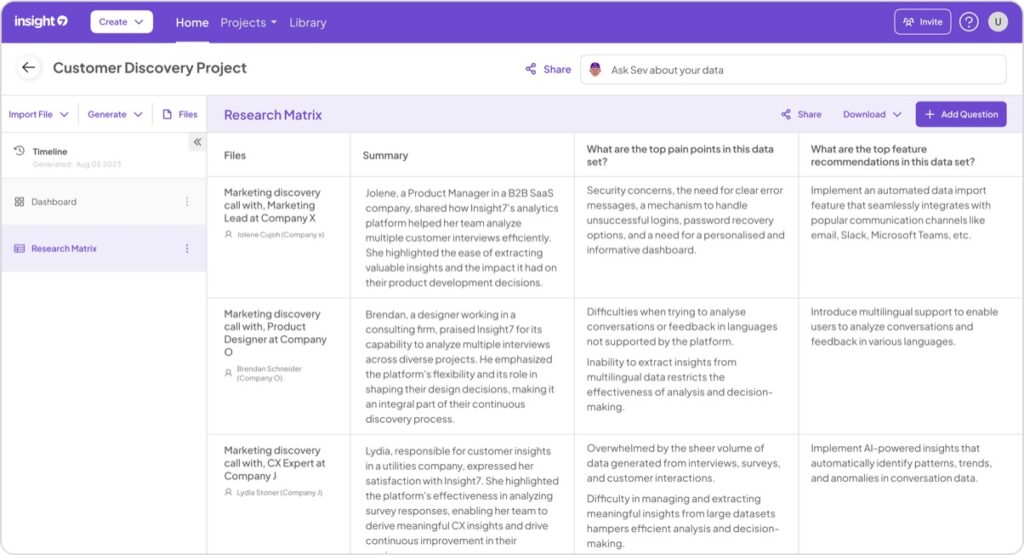Focus Group Analysis: Best AI Analysis Tools for Market Researchers
-
Hello Insight
- 10 min read


Focus group analysis is a crucial component of market research, providing valuable insights into consumer opinions and behaviors. It is essential for result-oriented marketing. Focus groups offer valuable qualitative insights into consumer behaviors, preferences, and perceptions. The introduction of AI tools has transformed this process by offering greater efficiency, accuracy, and depth of insight. This article explores how AI is enhancing focus group analysis and provides a detailed overview of the top AI tools for market researchers in 2024.
But before moving on, we should outline the process to give a better understanding of Focus group analysis:
- Data Collection and Preparation: Begin by collecting and preparing your data. This includes transcribing audio and video recordings and organizing notes accurately. Proper preparation ensures a smooth analysis process.
- Analysis: This stage involves multiple techniques to extract insights. You start by coding transcripts, assigning labels to relevant text. Then, you identify overarching themes. You might conduct sentiment analysis to gauge emotional responses., or content analysis to quantify specific topics. It is purely dependent on the type of analysis you want to do. Many researchers also do comparative analysis across groups and demographics. Advanced tools can even offer predictive analysis based on patterns in the data.
- Visualization: Once the analysis is complete, the next step is to visualize the findings. Effective visualization helps in conveying insights clearly and compellingly. Use charts, graphs, and infographics to represent data patterns and themes. Word clouds can highlight frequently mentioned terms, while bar charts or pie charts can illustrate the distribution of coded themes or sentiment scores.
The Impact of AI on Focus Group Analysis
AI tools address several key challenges in traditional focus group analysis:
1. Enhanced Speed and Efficiency: AI automates transcription, coding, and thematic analysis, allowing researchers to obtain insights more quickly and focus on strategic decisions.
2. Improved Accuracy: AI minimizes human errors in transcription and data coding, ensuring more reliable and consistent results.
3. Deeper Insights: AI algorithms identify patterns and themes that may not be immediately evident, offering richer and more actionable insights.
4. Scalability: AI efficiently handles large datasets, enabling comprehensive analysis without sacrificing quality.
Essential AI Tools for Focus Group Analysis
Here’s a detailed look at some of the most effective AI tools for focus group analysis, including their features, benefits, and potential drawbacks:
1. Insight7
Insight7 is a no-code SaaS platform designed for qualitative data analysis. It is designed to streamline the analysis of qualitative data with features like automated transcription, sentiment analysis, and theme identification. It offers powerful visualization tools, such as automated charts and graphs, which help in quickly visualizing trends and patterns. The sentiment analysis visuals provide a clear display of sentiment trends across data sets. Insight7’s user-friendly interface ensures that businesses can efficiently extract actionable insights from customer feedback and focus group data, making the analysis process both comprehensive, easy and straightforward.
Extract insights from interviews, calls, surveys
and reviews for insights in minutes
Key Features:
- Automated Transcription: Converts audio and video recordings into accurate text transcripts.
- Thematic Analysis: Identifies and extracts key themes and patterns from qualitative data.
- Customizable Reporting: Generates detailed and tailored reports based on focus group findings.
- Integration with Other Platforms: Seamlessly integrates with OneDrive, SharePoint, Gong, Google Drive, and more.
- Multi-Language Support: Analyzes data in various languages by translating it to English for processing and then back to the original language.
Pros:
- User-friendly with a straightforward learning curve.
- Cost-effective compared to many competitors.
- Comprehensive end-to-end solution with flexible reporting and multi-language capabilities.
- Generates insights quickly
Cons:
- Not suited for manual coding.
Analyze & Evaluate Calls. At Scale.

2. Delve
Delve is a user-friendly qualitative data analysis tool that simplifies the process of coding and finding patterns in qualitative data, including focus group transcripts. It offers collaborative features for team analysis, making it easy for multiple researchers to work together. Delve’s intuitive coding process and visualization tools help teams quickly identify and communicate key insights from their data.
Key Features:
- Advanced Coding: Offers dynamic coding and categorization options for detailed analysis.
- Thematic Visualization: Provides tools for mapping and analyzing themes effectively.
- Data Integration: Supports the integration of data from multiple sources.
- Collaborative Features: Enables multiple users to work on projects simultaneously.
Pros:
- Strong coding and visualization features.
- Effective for team-based research projects.
- Good for detailed thematic analysis.
Cons:
- Limited advanced analytical tools,
- Uses manual coding.
3. QuestionPro
QuestionPro is a comprehensive survey and research tool that includes capabilities for conducting and analyzing focus groups. It offers features like automated transcription, qualitative data coding, and robust analytics. QuestionPro’s all-in-one platform allows for easy integration of survey and focus group data, and its powerful analytics tools help in generating comprehensive insights.
Key Features:
- AI-Powered Insights: Utilizes advanced analytics to uncover insights from qualitative data.
- Survey Integration: Combines qualitative and quantitative data through seamless survey integration.
- Real-Time Reporting: Provides real-time updates and visualizations for immediate analysis.
- Customizable Dashboards: Tailors dashboards to specific research needs.
Pros:
- Comprehensive tools for both survey and qualitative analysis.
- Real-time reporting enhances data visibility.
- AI-driven analytics offer actionable insights.
Cons:
- Can be expensive,
- Some features may be more suited for survey data than in-depth qualitative analysis and advanced features may require additional training.
4. Taguette
Taguette is a free, open-source tool for qualitative research. It allows researchers to code, annotate, and analyze text data, making it suitable for focus group analysis. While it has a basic interface, it is easy to use and provides the essential tools needed for basic qualitative analysis. Taguette’s open-source nature makes it an excellent choice for researchers on a budget or those looking for a customizable solution.
Key Features:
💬 Questions about Focus Group Analysis: Best AI Analysis Tools for Market Researchers?
Our team typically responds within minutes
- Tagging and Coding: Intuitive tagging and coding features for qualitative data.
- Customizable Categories: Allows for the creation of custom coding categories.
- Data Organization: Manages and organizes large volumes of data efficiently.
- Open-Source Flexibility: Offers customization options due to its open-source nature.
Pros:
- User-friendly for coding and tagging tasks.
- Cost-effective due to its open-source model.
- Suitable for small to medium-sized projects.
Cons:
- Lacks some advanced features found in commercial tools.
- Requires technical expertise for extensive customization.
5. Dedoose
Dedoose is a web-based application that supports mixed methods research, combining qualitative and quantitative data analysis. It is particularly useful for coding transcripts, analyzing patterns, and visualizing data through various charts and graphs. Dedoose’s visualization capabilities help researchers easily identify and communicate key insights from their data. The platform’s collaborative features make it ideal for team projects, allowing multiple users to work together seamlessly.
Key Features:
- Mixed-Methods Analysis: Integrates qualitative and quantitative data for comprehensive analysis.
- Flexible Coding: Detailed coding and categorization options.
- Data Visualization: Various tools for visualizing data insights.
- Collaborative Features: Real-time updates for team collaboration.
Pros:
- Effective for mixed-methods research.
- Flexible coding and visualization options.
- Enhances team-based research with collaborative features.
Cons:
- Subscription costs can be relatively high.
6. Quirkos
Quirkos is an intuitive qualitative data analysis software designed to make coding and organizing data more accessible. It offers visualization tools to help researchers see patterns and connections in their focus group data. The software’s simple and user-friendly interface is perfect for small projects and beginners, making qualitative data analysis more approachable and less daunting.
Key Features:
- Visual Coding: Visual representation of themes and codes for intuitive analysis.
- Thematic Analysis: Facilitates the identification and analysis of key themes.
- Collaboration Tools: Allows multiple users to work on projects simultaneously.
- Data Export: Easy export of data and reports for further use.
Pros:
- Simplifies data analysis with a visual interface.
- User-friendly for researchers of all levels.
- Effective for theme identification and analysis.
Cons:
- Limited advanced analysis features.
- May not scale well for very large datasets.
7. MAXQDA
MAXQDA is versatile software for qualitative and mixed methods research, supporting focus group analysis with features for coding, categorization, and visualization. It offers excellent tools for team collaboration and supports a wide range of data types. MAXQDA’s visualization features, such as coding maps and interactive graphs, help researchers to present their data in a clear and impactful way. This makes it suitable for larger research projects that require detailed analysis and effective communication of results..
Key Features:
- Advanced Coding: Comprehensive coding and categorization tools for in-depth analysis.
- Data Visualization: Detailed visualization options to represent data insights.
- Mixed-Methods Support: Integrates qualitative and quantitative data for a holistic analysis.
- Rich Media Support: Handles various media formats, including text, audio, and video.
Pros:
- Robust features for complex qualitative analysis.
- Extensive data visualization tools.
- Supports a wide range of data formats.
Cons:
- Steep learning curve due to the extensive feature set.
- Higher cost may be a barrier for smaller teams.
8. ATLAS.ti
Atlas.ti is a powerful tool for handling large volumes of text, audio, and video data. It provides comprehensive tools for coding, network visualization, and thematic analysis, making it suitable for in-depth focus group analysis. The software’s network visualization features allow researchers to see connections and patterns in their data, providing a clear and organized way to present complex information. Its robust integration with other data sources further enhances its analytical capabilities. It provides automated coding suggestions using machine learning algorithms and also supports team-based coding and collaboration features.
Key Features:
- In-Depth Coding: Detailed coding tools for thorough data analysis.
- Data Visualization: Offers various visualization options to understand data insights.
- Mixed-Methods Analysis: Supports both qualitative and quantitative data integration.
- Collaborative Features: Facilitates teamwork with collaborative research tools.
Pros:
- Powerful coding and analysis capabilities.
- Rich data visualization and analysis tools.
- Good for team-based research with collaborative features.
Cons:
- Complex interface may be challenging for new users.
- Higher cost can be a barrier for smaller research teams.
AI tools have significantly transformed focus group analysis by enhancing speed, accuracy, and scalability. Insight7, Delve, QuestionPro, Taguette, Dedoose, Quirkos, MAXQDA, and ATLAS.ti each offer unique features tailored to different research needs. Insight7 stands out for its user-friendliness and affordability, making it accessible for a wide range of users. By leveraging these advanced tools, market researchers can streamline their focus group analysis processes and gain deeper, more actionable insights.
As AI technology continues to evolve, these tools will play a pivotal role in shaping the future of focus group analysis, offering new capabilities and efficiencies that drive research forward
In conclusion
The ultimate goal of focus group analysis is to derive actionable insights that inform decision-making and drive business outcomes. By distilling the findings into implications and recommendations, researchers provide stakeholders with clear guidance on leveraging the insights gained.
Whether informing product development strategies, refining marketing campaigns, or shaping organizational policies, the implications derived from focus group analysis serve as a roadmap for future action. Visit the Insight7 app to generate actionable insights from your focus group data.
Analyze & Evaluate Calls. At Scale.

💬 Questions about Focus Group Analysis: Best AI Analysis Tools for Market Researchers?
Our team typically responds within minutes



